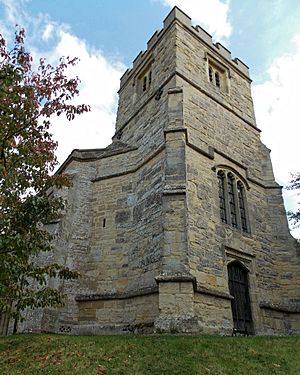Claydon House facts for kids
Quick facts for kids Claydon House |
|
|---|---|
 |
|
| General information | |
| Status | Complete |
| Type | country house |
| Location | Aylesbury Vale, Buckinghamshire, England |
| Coordinates | 51°55′19″N 0°57′20″W / 51.92194°N 0.95556°W |
| Construction started | 1751 |
| Owner | National Trust |
Claydon House is a large, historic country house in Buckinghamshire, England. It is located near the village of Middle Claydon. The main part of the house was built between 1757 and 1771. Today, it is owned by the National Trust, a charity that protects historic places.
The house is a Grade I listed building, which means it is considered a building of special importance. Its gardens are also listed as Grade II because of their historic value.
Contents
History of the House
The Verney Family
Claydon House has been the home of the Verney family since 1620. The family has a long and interesting history. Next to the house is the All Saints' church, which has many memorials to the Verneys.
One famous family member was Sir Edmund Verney. He was the special flag carrier for King Charles I during the English Civil War. He died defending the king's flag at the Battle of Edgehill in 1642. Some people say his ghost still haunts the house.
After the war, the king's son, Charles II, became king. In 1661, he gave Sir Edmund's son, Sir Ralph Verney, a special title called a baronetcy to thank the family for their loyalty.
Building a Grand Mansion
There has been a house on this spot since the 1400s. The Verney family began living there in 1620. But the house we see today was mostly built by Ralph Verney, 2nd Earl Verney, starting in 1757.
Lord Verney had big dreams for Claydon House. He wanted it to be as grand as the nearby Stowe House. He started by adding a new wing with fancy rooms for important guests. Then, he planned to add a huge, round entrance hall and a ballroom.
Unfortunately, Lord Verney ran out of money before the house was finished. He had to leave the country to avoid people he owed money to. After he died in 1791, his niece inherited the estate. She had to sell off parts of the unfinished house brick by brick to pay the debts. That's why the house today is much smaller than Lord Verney had planned.
The Look of the House
A Simple Exterior
From the outside, Claydon House looks quite simple and elegant. It has two floors with seven sets of large sash windows. The central part of the house stands out slightly and has a triangular top piece called a pediment.
An Amazing Interior
While the outside is simple, the inside is the complete opposite! The rooms are filled with incredible decorations in a style called Rococo, which is known for its fancy curves and detailed carvings.
The main rooms are full of amazing woodwork by Luke Lightfoot, a very skilled woodcarver. He carved decorations for the ceilings, walls, and doorways. The library also has a beautiful plaster Rococo ceiling.
One of the most stunning features is the main staircase. It is decorated with ivory and marquetry (patterns made from different types of wood). The iron railing of the staircase is shaped like ears of wheat. As you walk up the stairs, the iron pieces are said to rustle just like real wheat in a field.
The Chinese Room
Upstairs is the most famous room in the house: the Chinese Room. This is a fantastic example of Chinoiserie, a European style inspired by Chinese art. The whole room is a fantasy of carved temples, bells, and patterns. The most amazing part is a large canopy that looks like a Chinese temple. It once held a bed but now covers a sofa, making it look like a throne.
Florence Nightingale's Room
Also on the first floor is a small museum for Florence Nightingale, a famous pioneer of modern nursing. She was the sister of Parthenope, Lady Verney, who lived at Claydon House in the 1800s. Florence Nightingale often stayed at the house, especially when she was older.
Claydon House Today
The Verney family still has a connection to the house. They gave the house to the National Trust in 1956 so it could be preserved for everyone to enjoy. A member of the Verney family lived in a private part of the house until 2019.
Today, Claydon House is open to visitors. It's also used for fun events. Every year, a hovercraft race is held on the grounds.
The house has also been a popular location for filming movies. It has appeared in:
- Emma (1996)
- Far from the Madding Crowd (2015)
- The Aeronauts (2018)
- Cinderella (2021)
See also
- The Blacknall Map at Claydon House


